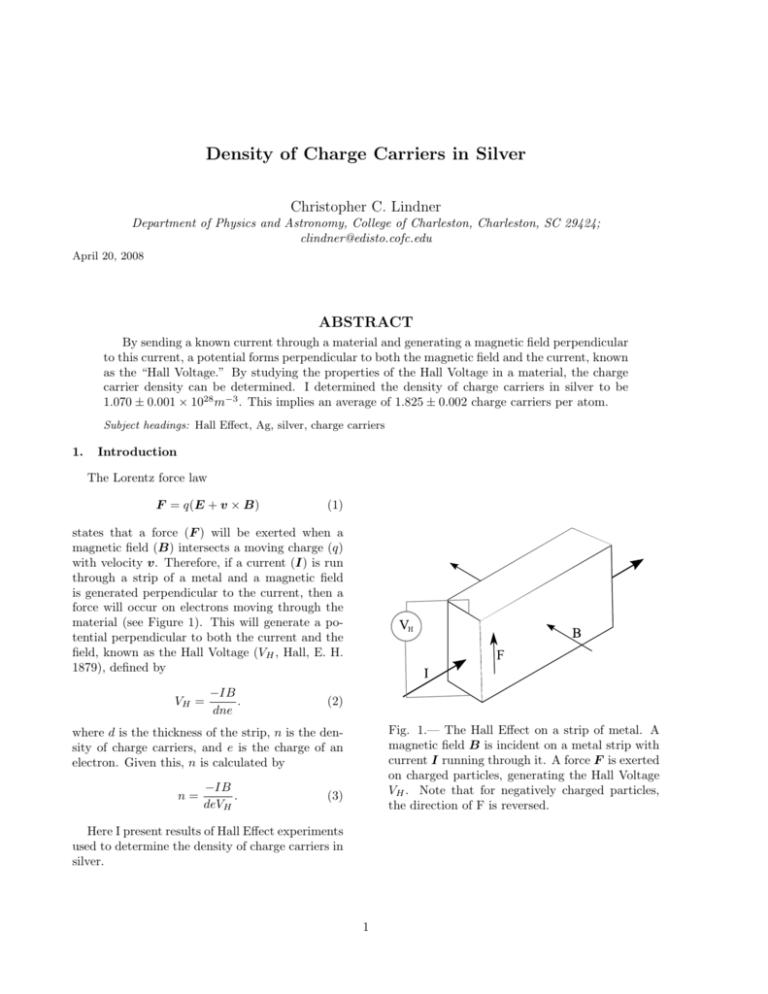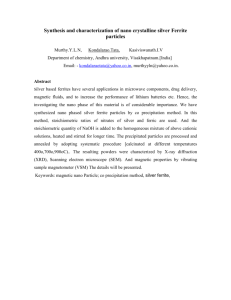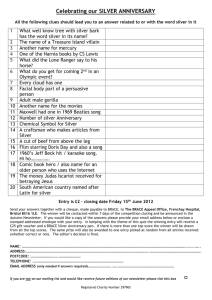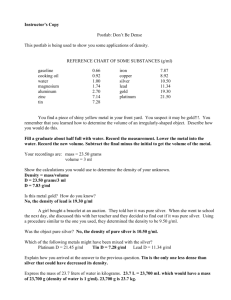Density of Charge Carriers in Silver
advertisement

Density of Charge Carriers in Silver Christopher C. Lindner Department of Physics and Astronomy, College of Charleston, Charleston, SC 29424; clindner@edisto.cofc.edu April 20, 2008 ABSTRACT By sending a known current through a material and generating a magnetic field perpendicular to this current, a potential forms perpendicular to both the magnetic field and the current, known as the “Hall Voltage.” By studying the properties of the Hall Voltage in a material, the charge carrier density can be determined. I determined the density of charge carriers in silver to be 1.070 ± 0.001 × 1028 m−3 . This implies an average of 1.825 ± 0.002 charge carriers per atom. Subject headings: Hall Effect, Ag, silver, charge carriers 1. Introduction The Lorentz force law F = q(E + v × B) (1) states that a force (F ) will be exerted when a magnetic field (B) intersects a moving charge (q) with velocity v. Therefore, if a current (I) is run through a strip of a metal and a magnetic field is generated perpendicular to the current, then a force will occur on electrons moving through the material (see Figure 1). This will generate a potential perpendicular to both the current and the field, known as the Hall Voltage (VH , Hall, E. H. 1879), defined by VH = −IB . dne (2) Fig. 1.— The Hall Effect on a strip of metal. A magnetic field B is incident on a metal strip with current I running through it. A force F is exerted on charged particles, generating the Hall Voltage VH . Note that for negatively charged particles, the direction of F is reversed. where d is the thickness of the strip, n is the density of charge carriers, and e is the charge of an electron. Given this, n is calculated by n= −IB . deVH (3) Here I present results of Hall Effect experiments used to determine the density of charge carriers in silver. 1 2. 5. Experimental Procedure Through exploitation of the Hall Effect, I have determined the charge carrier density and number of charge carriers per atom for silver. Not only do these values give scientific insight into the molecular properties of silver, this experiment has some historic interest as well: although Hall originally attempted his experiments with samples of silver, he was unsuccessful in verifying the effect that is his namesake in his initial experiments, and was forced to use a gold foil sample instead (Hall, E. H. 1879). This issue was likely a result of the low sensitivity of Hall’s instruments combined with his difficulty in obtaining a thin enough sample of silver. Here I have shown that the Hall Effect can be observed in silver. A silver strip thickness 0.05 mm was placed in the configuration seen in Figure 2. A magnetic field of strength 5 T was generated and current through the strip was varied from 10.0 A to 20.0 A in 0.5 A increments. VH was measured with a high-precision digital multimeter1 . The final value of n was determined by averaging the calculated values from each measurement. I would like to thank the College of Charleston Astronomy and Physics department for use of their facilities and equipment, and Jeff Wragg for his uncanny ability to find additional ways to make experiments frustrating. Fig. 2.— Experimental setup. Current I was generated through a strip of silver (Ag), and varied between 10 − 20A. A magnetic field of strength 5T was induced perpendicular to the strip, and directed via magnetic pole pieces. VH was measured via a multimeter, with probes placed at the top and bottom of the strip. 3. Conclusions REFERENCES Hall, E. H., American Journal of Mathematics, 287-292, 1879. Results Experimental results are shown in Table 1. The density of charge carriers in silver was determined to be 1.070 ± 0.001 × 1028 m−3 , averaging 1.825 ± 0.002 charge carriers per atom. 4. Discussion The value 1.825±0.002 charge carriers per atom corresponds to an average, as charge carrier density is known to be a function of position in most materials. Silver has one valence electron on its outer s orbital and 10 on its outer d orbital. This shows that, on average, only a small number of the valence electrons of silver are available as charge carriers. 1 Keithley 2000 Digital Multimeter This 2-column preprint was prepared with the AAS LATEX macros v5.2. 2 Table 1: VH Measured as a Function of I I (A) 10.0 10.5 11.0 11.5 12.0 12.5 13.0 13.5 14.0 14.5 15.0 15.5 16.0 16.5 17.0 17.5 18.0 18.5 19.0 19.5 20.0 VH (mV) -0.0051 -0.0054 -0.0060 -0.0062 -0.0065 -0.0070 -0.0076 -0.0079 -0.0083 -0.0085 -0.0088 -0.0091 -0.0093 -0.0095 -0.0099 -0.0100 -0.0102 -0.0102 -0.0104 -0.0105 -0.0107 Note.—Measurements of VH collected while varying I. Notice that values of VH are negative. 3







